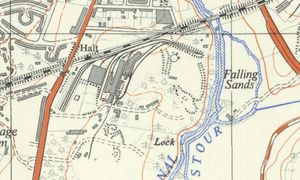Difference between revisions of "Foley Park sidings"
(add links, formatting etc) |
(additional info and history) |
||
| Line 2: | Line 2: | ||
'''Foley Park sidings''', located 1 mile 179 yards from [[Kidderminster Junction signal box|Kidderminster Junction]], were built in 1925 to serve the British Sugar Corporation factory at [[Foley Park]]. The sidings also provided a rail connection for the private sidings of [[Thomas Vale & Sons]] and [[Smethwick Drop Forgings Ltd. Siding|Smethwick Drop Forgings]]. They were located near [[Foley Park Halt]], which was moved from the south side of the line to the north side when the sidings opened. The sidings remained in use after the closure of the [[Kidderminster]]-[[Bewdley]] line on 6 January 1970, finally closing on 25 October 1982. | '''Foley Park sidings''', located 1 mile 179 yards from [[Kidderminster Junction signal box|Kidderminster Junction]], were built in 1925 to serve the British Sugar Corporation factory at [[Foley Park]]. The sidings also provided a rail connection for the private sidings of [[Thomas Vale & Sons]] and [[Smethwick Drop Forgings Ltd. Siding|Smethwick Drop Forgings]]. They were located near [[Foley Park Halt]], which was moved from the south side of the line to the north side when the sidings opened. The sidings remained in use after the closure of the [[Kidderminster]]-[[Bewdley]] line on 6 January 1970, finally closing on 25 October 1982. | ||
| − | + | ==Operations== | |
| + | Access to the sidings from Kidderminster was by means of a ground frame. See [[Ground Frames at Foley Park]]. | ||
| − | + | During the sugar beet season, which normally ran from mid-September to mid-January, up to four trains per day would arrive at Kidderminster. Shunting from Kidderminster to the Foley Park factory required a shunting engine from [[Kidderminster Shed]] to be available 24 hours per day.<ref>[[Bibliography#Books|Turley (2005)]] p. 72-77.</ref> | |
| + | |||
| + | Before World War 2 the BSC factory employed two Andrew Barclay 0-4-0ST shunting locomotives. They were joined by a third Andrew Barclay 0-4-0ST, "British Sugar Corporation No. 3", works no. 2248/1948, which arrived ex-works as part of a goods train on 1 May 1948.<ref>[[Bibliography#Books|Turley (2005)]] p. 76.</ref> | ||
| + | ==Preservation== | ||
In January 2016 the area was cleared of undergrowth to allow surveying on behalf of the [[Wagon Review Group]] for a potential new wagon storage facility to provide covered accommodation for the [[Goods Wagons|SVR's fleet of wagons]] along with a PW storage area and access for locomotives arriving by road. | In January 2016 the area was cleared of undergrowth to allow surveying on behalf of the [[Wagon Review Group]] for a potential new wagon storage facility to provide covered accommodation for the [[Goods Wagons|SVR's fleet of wagons]] along with a PW storage area and access for locomotives arriving by road. | ||
Revision as of 21:07, 8 July 2021
Foley Park sidings, located 1 mile 179 yards from Kidderminster Junction, were built in 1925 to serve the British Sugar Corporation factory at Foley Park. The sidings also provided a rail connection for the private sidings of Thomas Vale & Sons and Smethwick Drop Forgings. They were located near Foley Park Halt, which was moved from the south side of the line to the north side when the sidings opened. The sidings remained in use after the closure of the Kidderminster-Bewdley line on 6 January 1970, finally closing on 25 October 1982.
Operations
Access to the sidings from Kidderminster was by means of a ground frame. See Ground Frames at Foley Park.
During the sugar beet season, which normally ran from mid-September to mid-January, up to four trains per day would arrive at Kidderminster. Shunting from Kidderminster to the Foley Park factory required a shunting engine from Kidderminster Shed to be available 24 hours per day.[1]
Before World War 2 the BSCBritish Steel Corporation, or British Sugar Corporation factory employed two Andrew Barclay 0-4-0ST shunting locomotives. They were joined by a third Andrew Barclay 0-4-0ST, "British Sugar Corporation No. 3", works no. 2248/1948, which arrived ex-works as part of a goods train on 1 May 1948.[2]
Preservation
In January 2016 the area was cleared of undergrowth to allow surveying on behalf of the Wagon Review Group for a potential new wagon storage facility to provide covered accommodation for the SVR's fleet of wagons along with a PWPermanent Way storage area and access for locomotives arriving by road.
Historic maps of Foley Park sidings
- GWRGreat Western Railway plan of the northern part of Foley park sidings including Foley park Halt
- GWRGreat Western Railway plan of the southern part of Foley park sidings including the sand sidings on the opposite side.
- 1927 map showing the sidings and beet sugar factory
- 1938 map showing the sidings and the expansion of the beet sugar factory. The private sidings for Thomas Vale & Sons extends towards the bottom of the map
Photographs
- A DMU at Foley Park Halt. Comments on the link point out that the lack of traffic is likely due to sugar beet being a seasonal crop.
See also
- Private sidings connected to the Severn Valley Railway
- Pre-1963 map
- List of historical Signal Boxes and Ground Frames
References
- ↑ Turley (2005) p. 72-77.
- ↑ Turley (2005) p. 76.
- "Severn Valley Railway". Railways in Worcestershire article. Link. Accessed 09/01/2015.



